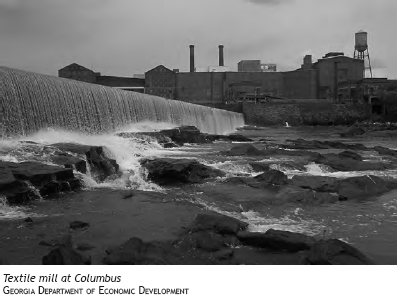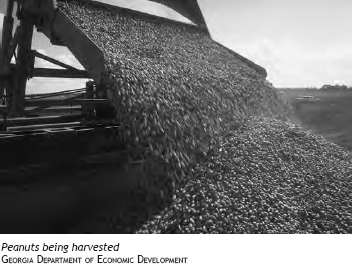
Georgia’s economy was based on agriculture in its early days. To a large extent, it still is. Now, it’s not known simply as farming, but as agribusiness. Much of the state’s economy today is based on farm and forest products. But the economy has diversified, just as the population has changed. The state is now home to high-tech industries; electronics, automobile, and textile manufacturing plants; retail stores; financial and educational institutions; and transportation facilities. Delta Airlines is based at Hartsfield-Jackson Atlanta International Airport. And countless millions of people around the world drink one of the many beverages produced by Atlanta’s Coca-Cola Company.
Consider these statistics:
Forty-one of the largest 1,000 companies listed in Fortune magazine have headquarters in Georgia, including Coke, Delta, CNN/Turner Broadcasting, Equifax, The Home Depot, Aflac, Internet Security Systems, Ciba Vision, Intercontinental Hotels and Resorts, Earthlink, and UPS.

The state leads the world in the production of carpet, kaolin, chickens, and watermelons. Georgia is the 11th-largest exporting state in the country.
Savannah is the second-largest port in the Southeast.
Eighty percent of United States markets and consumers can be reached in two hours by air or in two days by truck from Georgia.
Hartsfield-Jackson Atlanta International Airport is one of the world’s busiest airports, offering more than 500 direct flights to American and international cities.
Change in general has been good for the state, but Georgia has not been immune from national and global economic problems. The decline in sales for the American auto industry has resulted in cutbacks and projected closings of Ford and General Motors plants in the Atlanta area. Delta, one of the major airlines in the country, only recently emerged from bankruptcy and the elimination of several thousand jobs.
To better understand Georgia’s economy today, let’s take a look at how everything began and evolved.
When the first colonists arrived in Georgia with General James Oglethorpe, their mission was to establish homes in the New World and repay England by sending back furs, skins, precious metals, silk, corn, indigo, rice, and cotton. They practiced farming not only to survive but to satisfy the mother country’s need for commerce.
Oglethorpe was wise enough to ask Native Americans about their agricultural methods. Silk production also proved a success for the colonists, who shipped almost a ton of silk annually in the late 1760s. Since silk was much in demand among the aristocracy of Europe, England pressured the colonies to expand the industry. Oglethorpe established the Trustee Garden in Savannah for agricultural experiments and planted a number of mulberry trees, since silkworms feed on mulberry leaves.
Silk makers from Italy were brought to Georgia to teach the settlers how to process silk. The Salzburgers from Germany set up silk operations north of Savannah and succeeded for a while. Silkworms were susceptible to temperature changes, however, and the colonists turned to the more dependable crops of tobacco and cotton.

The early cotton grown was the sea-island variety, which had long fibers that were easily separated from the seeds. Sea-island cotton could be grown only along the coast because of the longer growing season. Upland cotton had shorter fibers and was much more difficult to remove from the seeds.
Cotton truly became king after Eli Whitney’s cotton gin mechanized the separation of cotton fibers from seeds and allowed short-staple cotton to be planted profitably in other areas of Georgia. As cotton production expanded throughout the state, so did the importation of slaves to plant, hoe, and harvest the crop. By the beginning of the Civil War, some 68,000 farms in Georgia were growing cotton.
After the war, farmers began to realize that repeated plantings of cotton in the same fields depleted the soil. While some abandoned worn-out land and moved to more fertile farmland, others turned to diversification of crops and gradually improved the soil’s fertility.
The arrival of the boll weevil in 1915 decimated cotton crops in Georgia and throughout the South, forcing many farmers to reduce their cotton plantings in favor of vegetables, poultry, and livestock. Others planted pine trees on acreage no longer suitable for cotton.
By the end of the 20th century, cotton farming had become mostly a corporate agribusiness involving mechanization, computerization, and planting on large tracts of land.
Today, cotton is still a significant money crop in Georgia. More than 1.5 million bales are harvested most years.
During the mid-1800s, Georgia became a leader in turning its cotton into thread and cloth. Attempts to operate factories in the early 1800s had failed in Wilkes County, Jefferson County, and Morgan County primarily because the frontier market was not lucrative enough.
The “Nullification Crisis” during the 1820s was a sectional dispute over states’ rights to nullify the tariff of 1828, which promoted American manufacturing over British competition. President Andrew Jackson was expected to reduce the tariff, and when he failed to do so, South Carolina declared the tariff unconstitutional. In 1833, the Force Bill was passed allowing Jackson to use military force against South Carolina. Fortunately, a new, lower tariff bill satisfactory to South Carolina also passed. The tariff policy would continue to be a divisive issue between the North and the South, one that would join slavery as a reason for the Civil War.
During the battle against tariffs, Georgia businessmen stepped up their efforts at textile production. Augustin Clayton of Athens and William Schley of Augusta built cotton mills near their towns and soon boasted huge profits. By 1840, the state had 14 cotton mills with more than 16,000 spindles.

Impressed with the profitability of the textile industry, Georgia legislators passed laws in 1847 making incorporation easier for textile companies than for other companies. By 1849, the number of textile mills more than doubled, from 14 to 35. The textile boom was under way.
The mill owners began to employ new technology as they expanded. Mills were built at the falls on rivers and creeks to harness power for the machines. Other factories were steam powered. The coarse fabrics first produced in the mills were called “Georgia wool.” Later, the mills made a heavier fabric called “cotton duck.”
As the factories expanded, finding white workers became a problem. Some slaves were used, and experienced workers from Northern mills were encouraged to move to Georgia.
Shortly before the Civil War, the textile bubble burst because of overproduction, overexpansion, and competition from Northern factories. By 1860, some 33 textile factories survived in Georgia. The entrepreneurs who had placed their bets on textiles turned to other businesses, such as financial and insurance companies and papermaking. Some set up plants to manufacture the machinery for textile mills.
Factory owners and farmers had learned a valuable lesson from the three-decade economic roller-coaster ride. When farm profits increased, textile mill profits decreased, and vice versa. Wise investors after that never put all their money—or cotton bolls—in one basket.
The mills that remained open during the Civil War made uniforms and supplies for the Confederate army. Since most able-bodied men were fighting in uniform, the work force was made up mostly of women. Their success led Union general William T. Sherman to target the mills as a way of crippling the Confederate economy and hastening the end of the war. During his March to the Sea, he ordered his troops to round up the women workers at New Manchester Mill and Roswell Mill and deport them to the North so they could not work elsewhere in the Confederacy. Then he burned the mills.
Despite the abolition of slavery and the destruction of many plantations, cotton production bounced back after the war to become the most important part of the state’s economy. But financial problems arising from the economic panic of 1873 resulted in a shift from an agricultural economy to an industrial one.
Henry W. Grady, a young editor at the Atlanta Constitution, was one of the voices calling for a New South to rise out of the ashes of the Old South. One of his solutions was to urge every Georgia town to build a cotton mill. New mills were constructed in the 1880s, and those abandoned or damaged during the war were rebuilt.
William Young rebuilt his Eagle Factory in Columbus and renamed it the Eagle and Phenix Mills. And in West Point, Civil War veterans Lafayette and Ward Lanier established West Point Manufacturing. Optimism returned to Georgians as Grady’s bold vision of the economic future took shape.
As the textile industry prospered, Northern investors began looking to Georgia as a promised land of lower taxes, cheap labor, and no unions. More mills were built in Augusta, Columbus, Macon, and LaGrange. By the end of the 19th century, the Georgia School of Technology opened its Textile Department to train future managers and engineers for the state’s 98 mills.
Georgia mill owners soon developed a system of mill villages that had been successful for New England factory owners. Begun in 1810 by New England mill owner Samuel Slater, the system involved providing company-owned housing for workers. This served two purposes: easy access for the workers and the creation of a sense of loyalty to the company among families living in the houses. The owners collected rent from the workers, the figure determined by how many family members worked in the mill.
Mill villages were a godsend to many families who moved from ramshackle farmhouses with no running water to decent housing. Sometimes, entire families, including wives and children, worked in the mills on different shifts. Two of the most famous mill villages in Georgia were Whitehall in Athens and Cabbagetown in Atlanta. Many of the workers for the Fulton Bag and Cotton Mills migrated to Atlanta from Appalachia.
The textile industry prospered into the 20th century as mills such as Bibb Manufacturing of Macon began producing hosiery, carpet yarn, and other products. In Dalton, chenille bedspreads, traditionally made by hand and sold at roadside stands, were the inspiration for tufted textiles and the carpet industry. North Georgia became the carpet center of the world, producing 80 percent of the carpet products sold on the international market.
The textile industry faced some grim years after World War I. Families had lost members in the war and the influenza epidemic of 1918. Farmers had lost entire cotton crops to the boll weevil. New and more efficient machinery meant fewer workers were needed. The workers who kept their jobs were required to operate more machinery to increase production.
The mills provided welcome employment for both white and black workers, but the African-Americans usually ended up with the lowest-paying jobs. Even as late as the 1950s and early 1960s, blacks were not allowed to live in the mill villages.
Just after World War I, hundreds of thousands of African-Americans in Georgia and the rest of the South began what is known as “the Great Migration” to Chicago, Detroit, and other Northern cities where higher-paying jobs were available in mills and automobile factories.
More changes came during the Great Depression. Some mills shut down, and those that remained open were required to follow new rules under President Franklin D. Roosevelt’s National Industry Recovery Act. Workers had to be at least 16, and the length of workdays was regulated. When mill owners refused to follow these rules, workers began to organize unions.
The clash between workers and management reached a crisis in the General Textile Strike of 1934, the largest labor protest in the history of the South. More than 170,000 Southern workers (along with 200,000 Northern workers) participated, including nearly 44,000 protesters in Georgia. Numerous incidents of violence took place in Georgia, and fatalities occurred in other states.
Governor Eugene Talmadge declared martial law and sent Georgia National Guardsmen to transport strikers from cotton mills in Coweta County to cells at Fort McPherson that had once held German prisoners of war. They were released when the strike ended three weeks later.
Anyone who thought the strikers had won was wrong. When they returned to their jobs, they found that working conditions had not improved. Those who had protested the loudest were evicted from their homes in the mill villages. It would take another world war before things changed for the better.
The World War II years were good ones for the textile industry in Georgia, as the mills landed government contracts for uniforms, gas masks, camouflage nets, and materials for parachutes. Jobs were plentiful for women and for men not eligible for the draft.
This period of prosperity extended through the 1950s, at least for the owners. As mills became more automated, workers were laid off and houses in the mill villages were sold.
More dramatic changes occurred upon the establishment of the Occupational Safety and Health Administration (OSHA). Owners who could not afford to update old and hazardous machinery simply shut down their mills. Others began outsourcing production to Asian markets where labor was cheap. By the mid-1990s, the number of textile workers was reduced to half of what it had been in the 1950s.
Textile manufacturing is still considered viable in Georgia because of the carpet industry and the availability of Hispanic workers. Meanwhile, many of the mills that have closed are being converted into other facilities. In Atlanta, for example, the Fulton Cotton Mill has been remodeled and rented as loft apartments.
An estimated one in six Georgians works in agriculture, forestry, or a related field. More than 11 million acres of land in the state are devoted to farms. Georgia leads the nation in the production of peanuts, pecans, poultry, eggs, and rye. It is second in the country in cotton production and is one of the largest producers of peaches, watermelons, and tomatoes. The state’s official onion, the Vidalia, is famous worldwide. Wheat, tobacco, soybeans, cottonseed, turf grass, and corn are also cultivated. Georgia is fifth in the country in tobacco acreage and first in the production of broilers, or young chickens.
The world’s largest poultry company was formed when Pilgrim’s Pride Corporation merged with Atlanta-based Gold Kist in 2006. Gold Kist was founded during the Great Depression by D. W. Brooks, an agronomy professor at the University of Georgia. Organized as the Cotton Producers Association (CPA), Brooks’s cooperative helped farmers in Georgia market their cotton. CPA soon diversified to sell farm supplies and fertilizer. It became Gold Kist in 1974 and began to focus on poultry.
Gold Kist provides farmers with chicken houses, labor, feed, equipment, and chicks. In return, the farmers sign contracts to raise the chickens. Gold Kist processes the mature birds and markets them. The deal allows farmers to reach global markets and reduces the risk of market fluctuations.
Cagle’s, which began as a small family-owned shop in Atlanta in 1945, is another major poultry producer in Georgia, boasting $300 million in revenue. Cagle’s chickens can be found in supermarkets and upscale restaurants and as chicken nuggets in fast-food restaurants.
Brothers William Howard Flowers and Joseph Hampton Flowers had one goal in mind when they started a small bakery in 1919: providing fresh bread to Thomasville residents. Today, Flowers Foods, famous for its “Little Miss Sunbeam” logo on Sunbeam bread, is one of the largest producers of baked goods in the country, its annual sales totaling more than $1.5 billion.
If you’ve bought any pecans grown in Georgia, chances are good they came from the South Georgia Pecan Company. The second-largest pecan-shelling company in the country processes more than 50 million pounds of pecans every year. The company was founded by the Pearlman family in Valdosta in 1905 and sold to Beatrice Foods in 1967. In 1983, Ed Crane and Jim Wom took over the company. After the pecans have been shelled and shipped, the empty shells are ground and sold to manufacturers that combine them with resin to make a woodlike product for furniture and building materials.
And let’s not forget peanuts, or “goober peas.” Georgia produces more peanuts than any other state. Its 755,000 acres of peanut fields yield more than 2 billion pounds a year. Peanuts are grown mostly in the sandy soil and warm climate of the Coastal Plain.

Although Georgia is known as “the Peach State,” two other states—South Carolina and California—actually have more peach orchards. Still, Georgia produces in excess of 2.5 million bushels every year. The Franciscan monks who came to Georgia with the Spanish introduced peaches in 1571 and taught the Cherokees how to grow them. In the 1850s, Raphael Moses of Columbus became one of the first men to profitably ship peaches to other states.
Georgia is not known for being a mining state, but it did have a brief period of gold fever when the precious metal was discovered in Lumpkin County. The county seat, Licklog, was renamed Dahlonega in 1833 for the Cherokee word tahlonega, or “golden.” Most of the mining was of the “placer” variety, in which prospectors sifted through the sand and gravel in creeks for gold. Later, mine tunnels were dug into the hills in search of veins of gold.
Gold was so plentiful for a while that Congress authorized the establishment of a mint at Dahlonega to make gold coins. When it closed at the beginning of the Civil War, the mint had produced 1.5 million coins.
While gold meant prosperity to some, it brought only misery and heartbreak to the Cherokees who had owned the land. With the exception of a few who fled to North Carolina to hide in the mountains, the Cherokees were removed and sent to Oklahoma on the Trail of Tears.
Just after the Cherokees were removed, the gold began to run out. A new strike in California in 1849 attracted thousands of Georgians harboring dreams of gold and glory. Most would have settled for gold.
In the 20th century, enough gold was still left in Dahlonega to refurbish the gold dome of the State Capitol in Atlanta.
One of the most profitable mining operations in Georgia today is for “white gold,” or kaolin. Georgia is the largest kaolin producer in the country, mining some 8 million tons of the white clay every year. Found in the part of Georgia below the fall line, kaolin is used as a paper coating, in pharmaceuticals, and in ceramics and paints.
Granite is another natural resource that has been extremely profitable for Georgia. Elberton, in the northeastern part of the state, is known as “the granite capital of the world.” Forty-five quarries produce rough blocks of granite that are sent to manufacturing plants for grave markers, memorials, and building products such as granite countertops.
Marble is quarried in the town of Tate in Pickens County. Georgia marble has been used all over the world and in 60 percent of the monuments in Washington, D.C. The original Georgia Marble Company, bought and resold several times, is now owned by the Canadian company Polycor. Its United States headquarters is located in Tate.
The timber industry has been part of Georgia’s economy ever since the first settlers set up sawmills to send lumber to England.
What is now Georgia-Pacific began as a small lumber company in Augusta in 1927. Twenty years later, the Georgia Hardwood Lumber Company became Georgia-Pacific Plywood and Lumber Company. Koch Industries acquired Georgia-Pacific for $21 billion in 2005. Georgia-Pacific is the second-largest producer of paper products in North America and the largest supplier of building products. The company has more than 600 facilities in the United States and other countries.
Folks who happen to drive along the coast near Savannah sometimes get a whiff of an odor like rotten eggs. The scent may be unpleasant to tourists, but residents consider it the sweet smell of success. Union Camp turns forest products into pulp, paper, bags, and packaging materials. The Savannah plant, the largest of the New Jersey–based company’s facilities, manufactures more than a million tons of paper products every year.
Atlanta not only has one of the busiest airports on the planet, it will be home to the world’s largest airline once all the legal documents have been signed for the merger of Delta Air Lines with Northwest Airlines. Not bad for a company that began as an aerial crop-dusting outfit in Macon in 1924. Huff Daland Dusters was renamed Delta Air Service after the company moved to Monroe, Louisiana. New owner C. E. Woolman named the company after the Mississippi Delta. The airline moved its headquarters to Atlanta in 1941. Delta long has been one of Atlanta’s major employers, but rising fuel costs and other factors forced the airline into bankruptcy and resulted in layoffs a few years ago. It emerged successfully in 2007 by restructuring and downsizing. Now, with the Northwest merger and the expansion of flights to Beijing, China, and other international cities, Delta expects to weather the fuel crisis and return to profitability.
United Parcel Service (UPS) began in Seattle but moved its headquarters to Atlanta in 1991. UPS is a multibillion-dollar corporation that delivers more than 13 million packages worldwide every day. The company has a fleet of 88,000 vehicles and 360,000 employees.

Savannah-based Gulfstream Aerospace Corporation, a subsidiary of General Dynamics, produces aircraft for corporations and private individuals in the United States, Europe, Asia, and the Middle East. Gulfstream planes range in price from $11 million to $46 million. The planned expansion of the Savannah plant is expected to add 1,100 new jobs by 2013.
Since beginning with two stores in Atlanta in 1978, The Home Depot has grown into the world’s largest home improvement center. The company now operates stores in Canada, Mexico, Chile, and every state in the union. The Home Depot was founded by Bernie Marcus and Arthur Blank after the two men were fired on the same day by Handy Dan Home Improvement Centers in California. The unemployed executives got together to create a plan for a chain of home improvement warehouses that would offer hardware, lumber, and building supplies to both contractors and average consumers. By 2004, sales had reached $60 billion. Marcus and Blank have since retired to devote their time to philanthropic interests. Blank also bought the Atlanta Falcons pro football franchise.
The Centers for Disease Control and Prevention (CDC) in Atlanta is world-famous for its efforts in controlling infectious diseases and preventing epidemics. As part of the United States Department of Health and Human Resources, the CDC has a mission that includes vaccinations, nutrition, and family-planning programs around the world. The CDC played a key role in the eradication of smallpox and the identification of the Ebola virus. Today, it has the added responsibility of combating bioterrorism, such as the use of anthrax and other potential biological weapons.

For a while beginning in the 1970s, it looked like Georgia might become a haven for Hollywood filmmakers. Geographically, the state had everything—mountains, urban centers, islands, beaches, swamps, forests, and vast fields. If the film folks needed a plantation house, we had plantation houses. Looking for a weathered, unpainted shack? We had plenty of those. Need a wild and scenic river where four middle-aged canoeists could test their survival skills? How about the Chattooga?
The film and video industry has contributed more than $5 billion to the state’s economy since the Georgia Film Commission was established in 1973. That’s a hefty amount, but Georgia has not succeeded as well as North Carolina and other places. In an effort to make Georgia more attractive to movie and television producers, Governor Sonny Perdue signed the 2008 Entertainment Industry Investment Act. The act provides a 20 percent tax credit for certain productions and another 10 percent tax credit if a Georgia logo is used in the film or video.
In 2008, the state reported 279 total entertainment productions, including 10 feature films, 46 television programs and series episodes, 171 commercials, 44 music videos, and eight video game projects.
More than 400 motion pictures and countless TV movies and shows have been made in Georgia, but most are not about Georgia. Gone With the Wind, the movie most people associate with Georgia, was filmed on a set in Hollywood. An ample amount of Georgia’s red clay was transported there, however.
Movies not only boost the economy of the location where they’re shot, they also create longer-lasting benefits. Deliverance, shot on the Chattooga River in Rabun County, sparked a huge interest in whitewater canoeing and tourism in the North Georgia mountains. The film Midnight in the Garden of Good and Evil, along with the best-selling book by John Berendt, increased tourism in Savannah by an estimated 60 percent. Fried Green Tomatoes turned the tiny town of Juliette into a major destination for tourists who wanted to sample the vegetarian delicacy at the Whistle Stop Café. The jobs the movie and TV companies create while they’re shooting on location are another positive side effect.
Not all the films made in Georgia have been award winners, and not all have portrayed the state in a favorable light. Deliverance angered some of the mountain people of Rabun County because it presented them as ignorant and inbred, not to mention perverted. The 1932 film I Am a Fugitive from a Chain Gang created a national outcry that resulted in prison reform legislation in Georgia. Smokey and the Bandit and several other Burt Reynolds movies did little to improve the state’s image in the eyes of the rest of the country.
On the other hand, Georgia can be proud of Driving Miss Daisy, the Academy Award–winning film about an Atlanta Jewish woman and her black chauffeur; Glory, the Civil War film starring Denzel Washington; and Daughters of the Dust, a story of an African-American Gullah community on the sea islands in 1902.
Tourism continues to be Georgia’s second-largest industry. Georgia is the seventh-most-visited state in the country. Every year, 48 million visitors spend about $25 billion at hotels, restaurants, parks, and other places. New attractions such as the Georgia Aquarium and the New World of Coca-Cola in Atlanta and the Georgia Music Hall of Fame and the Georgia Sports Hall of Fame in Macon are expected to boost tourism even more.
Savannah, of course, will continue to ride the wave of national and international publicity generated by Midnight in the Garden of Good and Evil.
Top 10 Fortune 500 Companies in Georgia
1. Home Depot (www.homedepot.com)
2. United Parcel Service (www.ups.com)
3. Coca-Cola (www.thecoca-colacompany.com)
4. Coca-Cola Enterprises (www.cokecce.com)
5. Delta Air Lines (www.delta.com)
6. Aflac (www.aflac.com)
7. Southern (www.southerncompany.com)
8. SunTrust Banks (www.suntrust.com)
9. Genuine Parts (www.genpt.com)
10. Mohawk Industries (www.mohawkind.com)
Dabney, Joseph Earl. Herk: Hero of the Skies. Fairview, N.C.: Bright Mountain Books, 2003.
Georgia Department of Economic Development. www.georgia.org.
New Georgia Encyclopedia. www.georgiaencyclopedia.org.